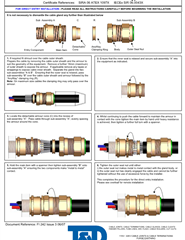My understanding is/was that when using an SWA it needs to have a gland on each end for the armoured steel. Normally/ideally the gland should enter the enclosure from the underside and it would normally have a shroud over the top. If you take the standard BW or CW (other brands and types are available like Storm Glands).
While having a discussion recently with a friend who deals with ATEX a lot he said that the shroud would be better not being fitted in a lot of situations. Take for example a gland that is outside your dwelling where it is exposed to the elements the shroud can get condensation inside and not have a means for draining. The gland itself is normally OK as mainly made from brass but the Amour of the SWA can start to corrode. This can also happen is some production environment where there is moisture in the air.
I wonder what thoughts people have about this concept of no shroud for an SWA?
As always please be polite and respectful in this purely academic debate.
Come on everybody lets help inspire the future.
